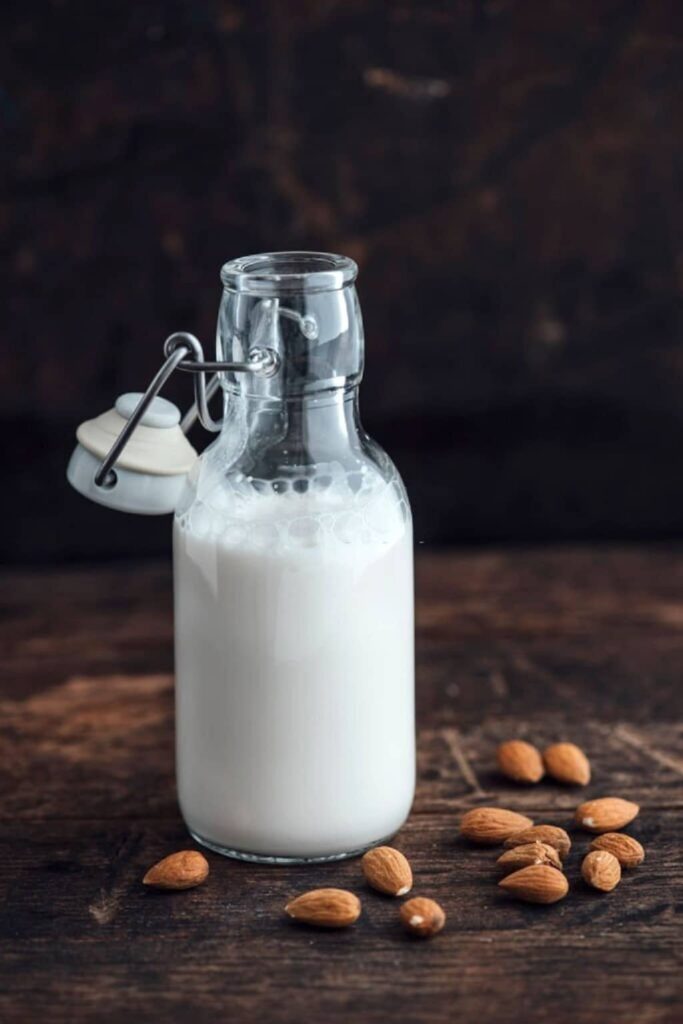Yes, you can freeze almond milk. Freezing almond milk is an easy way to keep it fresh longer and keep it from going to waste.
Make sure to shake or stir the almond milk well before you freeze it to make sure the fats and liquids are well mixed. Keep in mind that almond milk may have a slightly different taste after it has been frozen and thawed.
When you want to use the frozen almond milk, just put it in the fridge to thaw. After it has thawed, give it another good shake or stir to bring back together any parts that have separated.
But you shouldn’t drink frozen almond milk because the taste might not be as nice when it’s liquid.

What is Almond Milk?
Almond milk is a non-dairy milk alternative made by blending almonds with water.
It is a popular alternative to cow’s milk for people who are lactose intolerant, vegan, or allergic to dairy.
Almond milk is lower in calories and fat than cow’s milk, and it is a good source of vitamin E, magnesium, and potassium.
How Long Does Frozen Almond Milk Last?
Almond milk that has been frozen can stay there for about 3 to 6 months.
However, its quality might diminish over time. Labeling packages with the date they were frozen is best, and when using them, make sure they are properly thawed and mixed to avoid texture changes
How to Freeze Almond Milk

Freezing almond milk is a simple process. Here’s how to do it:
- Select a Container: Freeze in a clean, airtight container or bag. Make sure it’s freezer-safe to avoid freezer burn and preserve milk quality.
- Leave Room for Expansion: pour almond milk into the container with some room at the top. Seal the container tightly to keep air out.
- Label and Date: Mark the container with the freezing date. This helps you track freezer time.
- Stir Before Freezing: Give the almond milk a good stir before freezing to ensure any separated components are well mixed.
- Freeze Quickly: Place the sealed container or bag in the freezer to freeze quickly. Keep it at 0°F (-18°C) or lower.
- Thawing: Slowly defrost frozen almond milk in the fridge before using. The quantity may take many hours or overnight.
- Shake or Stir After Thawing: Since freezing might cause separation, shake or stir the almond milk after thawing to reunite any separated components.
- Use Within a Few Days: Consume the thawed almond milk within a few days for the best taste and quality. It may change texture after freezing, so use it in smoothies, cooking, or baking.
Follow these Steps to freeze almond milk for later use.
How To Defrost Frozen Almond Milk?
To defrost frozen almond milk, follow these steps:
- Refrigerator Method: The best technique to defrost almond milk without losing flavor or texture. Refrigerate almond milk in a frozen container or bag. Thaw it slowly over several hours or overnight. This delayed thawing procedure preserves milk quality.
- Cold Water Bath: Thaw almond milk faster with a cold water bath. Put the sealed frozen almond milk bag in a bigger bowl of cold water. Keep water cool by changing it every 30 minutes. This method takes several hours to thaw.
- Microwave Method (for Immediate Use): While not ideal, you can microwave almond milk. Transfer a tiny amount of frozen milk to a microwave-safe container and thaw or low power. Stir often and heat it in short intervals to melt evenly. Avoid overcooking, which changes milk texture.
- Stir or Shake: After thawing in the fridge or water bath, shake or stir the almond milk to recombine any separated ingredients. Almond milk can separate solids and liquids when frozen.
How To Use Defrost Almond Milk?
Depending on your desire and use, defrosted almond milk is easy to use. How to use:
- In Beverages: Use defrosted almond milk in coffee, tea, smoothies, or any dairy-free milk substitute. Use it cold or gently warmed; overheating may affect the texture.
- Cereal And Oatmeal: Defrosted almond milk can be poured over cereal, granola, or oatmeal as fresh almond milk.
- Cooking: Almond milk can be used in milk-based recipes. Sweet and savory soups, sauces, pancakes, and pastries use it. Equal volumes of defrosted almond milk can replace dairy.
- Desserts: Add nutty flavor to puddings, custards, and ice creams. Also used in dairy-free sweets.
- Smoothies: Add defrosted almond milk to your favorite smoothies for a creamy, nutritious base.
- Dips and Dressings: Mix it into homemade dips, salad dressings, or marinades for a dairy-free, nutty taste.
- Hot Chocolate: Mix cocoa powder and sweetener with defrosted almond milk to produce dairy-free hot chocolate.
Final Thoughts
Without losing flavor or nutrition, almond milk freezes. Frozen almond milk is cheaper and lasts longer.
Cool the almond milk in an airtight jar with room to expand. Thaw frozen almond milk overnight in the fridge and mix before using.
Instead of freezing almond milk, buy smaller containers or make it.
FAQs
- Can you freeze almond milk in its original carton?
No, it is not recommended to freeze almond milk in its original carton. Instead, transfer the almond milk to an airtight container before freezing. - Can you freeze homemade almond milk?
Yes, you can freeze homemade almond milk. Follow the same steps as you would for store-bought almond milk. - Can you use frozen almond milk in smoothies?
Yes, frozen almond milk is great for adding to smoothies. It can also be used in baking recipes that call for almond milk. - Can you refreeze almond milk?
It is not recommended to refreeze almond milk after it has been thawed. - Is it safe to drink almond milk that has been frozen?
Yes, it is safe to drink almond milk that has been frozen as long as it has been thawed properly and used within three months of freezing.

